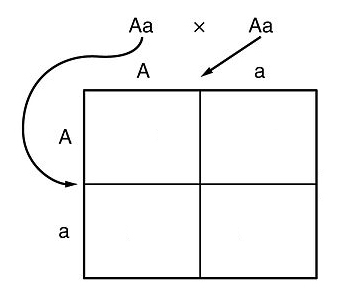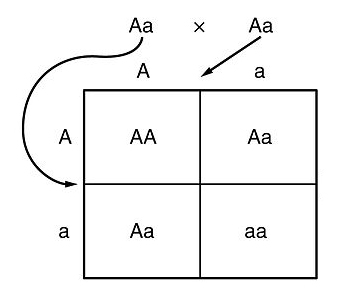Mendel's second experiment yielded a different result than his first. As with the F1 plants, no pale purple or intermediate color flowers bloomed in the F2 plants. This led Mendel to deduce that color traits do not blend in pea plants. When F2 plants developed both white and purple flowers, Mendel realized that the trait for white flowers was not eliminated but only repressed for a generation.
Using a Punnett square, Mendel could have predicted how many white-flowered and purple-flowered plants to expect in each future generation. The slides below demonstrate how.
Step 1: Record the genotypes of both the parents.Remember that the heterozygous pea plants of the F2 generation were self-pollinated, as occurs in nature, and the alleles were as follows: male - Aa Step 2: Consider the law of segregation.According to the law of segregation, the parent can only pass one copy of its allele to its offspring. The male and female each pass on one allele, giving the offspring a total of two alleles. Each male and female gamete contains just one allele. Male Gamete - A or a Step 3: Draw an empty Punnett square.The number of columns and rows of the Punnett square is determined by the number of male and female gametes. In this case, the male and female have two gametes each, so the table would need two rows and two columns. Place the male gametes across the top of the Punnett square and the female gametes to the side of the square.
Step 4: Fill in the allele pairs to be found in the gametes.Combine the alleles of the gametes in the empty boxes and fill in the possible genotypes as shown in the picture.
Calculate the possible genotypes.Count the different genotypes that appear in the Punnett square. In this case, the possible genotypes are AA, Aa, and aa. The AA and Aa genotypes contain the dominant A allele, so you know they'll produce purple flowers while aa genotypes can only produce white flowers. The Punnett square shows a ratio of three dominant genotypes and one recessive genotype, which means there will be three purple-flowered plants for every one white-flowered plant.
|
Question
Use a Punnett square to predict the outcome of a heterozygous tall plant (Tt) being crossed with an another heterozygous tall plant (Tt).

